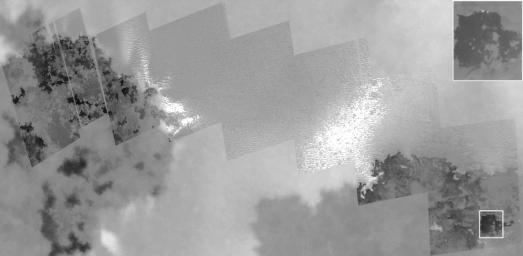This high-resolution mosaic of images taken by NASA's Galileo spacecraft shows lava flows, bright streaks, and ridged plains at the northern margin of the lava flow field at the volcanic center Prometheus on Jupiter's moon Io. The images, taken during a flyby of Io on February 22, 2000, have a resolution of 12 meters (39 feet) per picture element.
The lava is erupting from a fissure about 40 kilometers (25 miles) east (right) of the edge of this mosaic, and the 100 kilometer (62 mile) tall Prometheus plume is erupting from somewhere near the western end of this mosaic. This mosaic was acquired to search for and image the plume vent or vents. We expected to see a small crater surrounded by radial streaks, but no such central vent can be seen in these or other images. Instead, we see bright streaks along the margins of the lava.
The darkest areas are warm lava flows. Warm lava is dark because it is either too hot or too recent for significant amounts of sulfur-dioxide frost or snow from the plume to have condensed onto it. The blow-up shows two bright dots where hot lava is breaking out of the edge of one of the dark lava flows. The bright, ridged plains to the north of the lava are probably rich in sulfur dioxide. The formation mechanism for the ridges is unclear. The very bright streaks radiating from the area where the lava flows overrun the field are where the hot lava recently vaporized the sulfur dioxide, which then coated the lava-facing sides of the ridges.
The Prometheus plume has been seen by both the Voyager and Galileo spacecraft whenever the viewing geometry has been favorable. While the morphology of the plume has been nearly constant, the plume's position jumped about 80 kilometers (50 miles) between the Voyager observations in the 1970s and the Galileo observations since 1995. The lava flow field has migrated a similar distance. Galileo scientists are currently investigating whether fresh lava breakouts overrunning plains rich in sulfur dioxide can help explain the plume observations.
The Jet Propulsion Laboratory, a division of the California Institute of Technology in Pasadena, manages the Galileo mission for NASA's Office of Space Science, Washington, D.C. Additional information about Galileo and its discoveries is available on the Galileo mission home page at http://galileo.jpl.nasa.gov. Background information and educational context for the images can be found at http://solarsystem.nasa.gov/galileo/gallery/index.cfm.

 Planetary Data System
Planetary Data System












